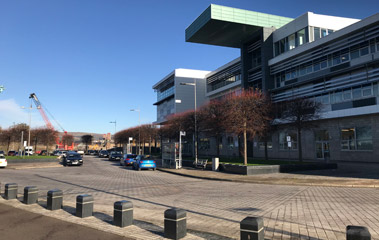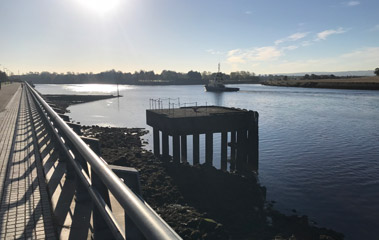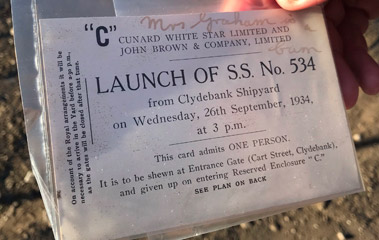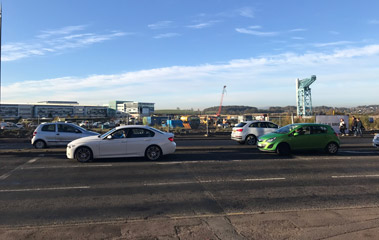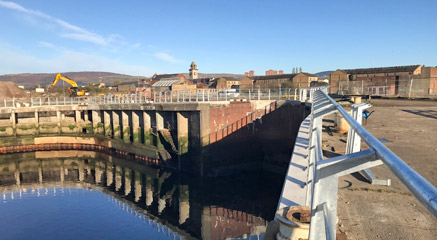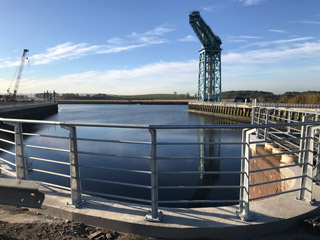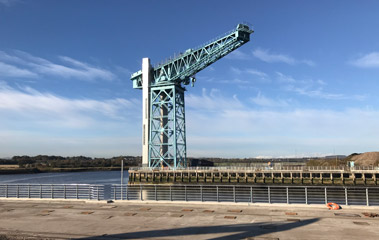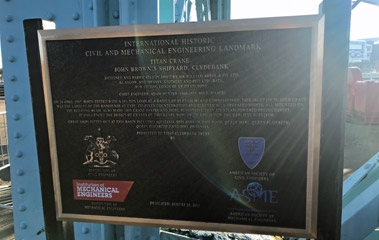A well-kept secret
This isn't a tourist attraction. There's no visitor centre, no heritage trail, no blue plaques. John Brown's shipyard, the famous Brown's of Clydebank where Britain's greatest liners were built, is now partly buried under a modern college and a leisure centre and part wasteland awaiting development. But by lurking furtively in a car park you can stand on hallowed ground, on the spot where the Lusitania, Aquitania, Empress of Britain, Queen Mary, Queen Elizabeth and even the QE2 were built. And by lurking furtively by the leisure centre next door, you can stand where WW2 battlecruiser HMS Hood was built.
You won't find this famous site marked on the map. I found it by comparing aerial photos of the Queen Mary under construction with today's Google Maps. But it's easy to reach, and accessible. Once there, you can walk around the area freely.
How to get there
Trains link Glasgow Central with Clydebank 4 times per hour, taking around 21 minutes, see www.scotrail.co.uk.
It's a mere 4 minutes walk from Clydebank railway station to the fitting-out basin of John Brown's shipyard, 9 minutes walk to the southern end of the main slipway where Queen Mary, QE2, Aquitania & Lusitania were built, or 10 minutes walk to the southern end of the slipway used for HMS Hood, HMS Repulse & HMS Vanguard.
Tip: There's a cafe in the Co-Op department store in the town, just north of the station. A good place for a coffee before or after your visit, in a listed building dating from 1916. This Co-op has always played a significant role in the Clydebank community.
John Brown's shipyard overview
The map below was provided courtesy of West Dunbartonshire Council, it shows the position of John Brown's slipways, superimposed on the modern college and leisure centre buildings. The main slipway is the one on which Lusitania, Aquitania, Empress of Britain, Queen Mary, Queen Elizabeth and QE2 were built. The red ship shows the location of HMS Hood as she was being built. The green shapes show the location of shipyard buildings and sheds, now all gone. The royal yacht Britannia was also built here. You can read more about John Brown's of Clydebank at en.wikipedia.org/wiki/John_Brown_&_Company.
The main slipway
The Lusitania, Aquitania, Empress of Britain, Queen Mary, Queen Elizabeth and QE2 were all built on the same slipway, John Brown's longest and largest. The bows of these great liners would have towered over the various sheds at the inland end, now long gone. The sterns would have been hanging over the water. If you look at this map you can see that the main slipway is angled towards a tributary of the Clyde called the River Cart, as the extra room afforded by the mouth of that tributary was needed to launch these huge ships.
Panorama photo of the college.
Above left, the college building, taken with my back to the Clyde. In 1934, I'd be standing under the stern of the Queen Mary!
Above right, the waterfront where the slipways went into the water, looking towards the mouth of the River Cart on the other side of the Clyde.
Above left, an invitation to the launch of number 534, the Queen Mary.
Above right, the view from the main road over wasteland towards the college and fitting out basin, with all the many sheds of Jon Brown's shipyard now long gone.
Above, a view from the north end of the fitting-out basin towards the college, across what would have been John Brown's main slipway. In 1934, the looming bulk of the Queen Mary would have taken up almost all of this view.
The fitting-out basin
After being launched into the Clyde, all of these great liners - and HMS Hood - would have been towed round to the fitting-out basin for completion. The Queen Mary and Queen Elizabeth were so long that a 'notch' had to be built at the north end of the basin, to prevent the stern sticking too far out into the Clyde. The notch can still be seen today.
Panorama photo of the fitting-out basin, with the Titan crane at the far end, college (and former main slipway) on the left.
The notch, from both sides.
Titan crane
The Titan crane was the world's first electrically powered cantilever crane, and the largest crane of its type when it was built. Before the pandemic it was open to the public, but it hasn't been open for a while now and their official website is unavailable. See en.wikipedia.org/wiki/Titan_Clydebank.
If you're staying in Glasgow
If you're planning to stay in Glasgow, the city's landmark hotel is Voco's Grand Central, one of Britain's great railway hotel, opened by the Caledonian Railway in 1883. Located on Glasgow Central station where trains from London and the south arrive, everyone who's anyone has stayed here, from Winston Churchill to the Beatles to Gene Kelly, Fred Astaire, Laurel & Hardy and Frank Sinatra.
The Voco Grand Central Hotel, Glasgow.
The hotel bar, Champagne Central, is the ideal place to wait for a train south, overlooking the concourse at Glasgow Central station.






